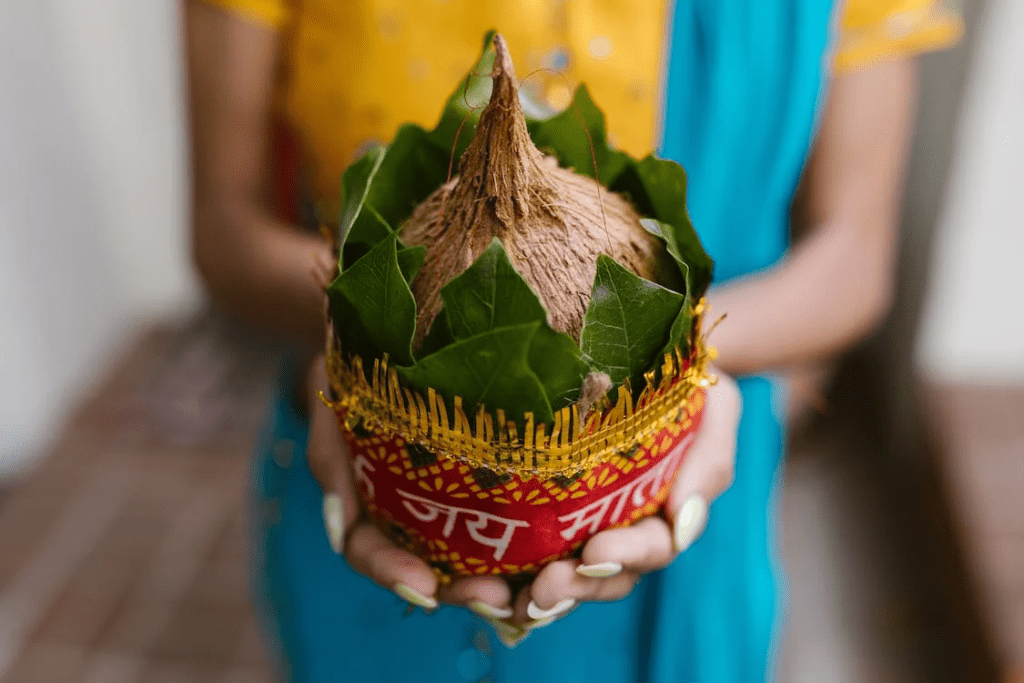Introduction
Navratri, one of the most vibrant and spiritually significant festivals in India, is just around the corner. This nine-night celebration is dedicated to the worship of the Divine Feminine and embodies the triumph of good over evil. In this blog, we will explore the importance of Navratri, the ritual of Kalash Sthapana (the establishment of a sacred pot), and provide you with some powerful Sanskrit mantras along with their English meanings to enhance your Navratri experience.
The Significance of Navratri
Navratri, which means “nine nights” in Sanskrit, is celebrated with fervor and devotion across India. This festival is observed in honor of Goddess Durga, who represents the embodiment of divine feminine energy and strength. The significance of Navratri can be summarized as follows:
- Victory of Good over Evil: Navratri commemorates the victory of Goddess Durga over the demon Mahishasura. It symbolizes the triumph of good over evil, light over darkness, and righteousness over wickedness.
- Nine Forms of the Goddess: Each of the nine nights of Navratri is dedicated to a different form of Goddess Durga, each with her unique attributes and qualities. Devotees seek her blessings for courage, wisdom, and prosperity during these nights.
- Fasting and Purity: Many people observe fasts during Navratri to purify the body and mind. It is a time for self-reflection, spiritual growth, and connecting with the divine.
Kalash Sthapana: The Ritual of Setting Up the Sacred Pot
Kalash Sthapana is a vital ritual during Navratri, symbolizing the establishment of the divine presence within your home. Follow these steps for a successful Kalash Sthapana:
- Select an Auspicious Day: Traditionally, the Kalash is installed on the first day of Navratri. It’s essential to choose an auspicious time for this ritual. Consult a priest or an astrologer for the right timing.
- Prepare the Kalash: Fill a clean, copper or earthen pot with water. Place a coin, some rice, and a betel nut inside the pot. Cover the mouth of the pot with a coconut wrapped in red cloth. The coconut represents Lord Ganesh, who is worshipped first.
- Cleanse and Decorate: Cleanse the area where you plan to install the Kalash. Decorate the pot with turmeric, kumkum, flowers, and leaves, especially mango leaves.
- Invocation of Deities: Before placing the Kalash, offer prayers to Lord Ganesha, seek his blessings, and invoke the divine presence.
- Sthapana of Kalash: Place the Kalash at the spot you’ve prepared, ideally near the entrance or in a sacred space within your home. Ensure it is stable and will not be moved during the nine days of Navratri.
- Prayers and Mantras: Perform daily prayers, light a lamp, and recite mantras dedicated to the Goddess during the nine days.
Navratri Mantras in Sanskrit and Their English Meanings
Navratri is a time for chanting powerful mantras that invoke the blessings of the Goddess. Here are some significant Navratri mantras in Sanskrit along with their English meanings:
- Durga Mantra:
- Mantra: “ॐ दुं दुर्गायै नमः”
- Meaning: This mantra is a salutation to Goddess Durga, seeking her divine protection and blessings for courage and strength.
- Lalitha Sahasranama:
- Mantra: “ॐ ललिताम्बिकायै नमः”
- Meaning: This mantra is a part of the Lalitha Sahasranama, which comprises a thousand names of Goddess Lalitha. It is a hymn of praise and devotion to the Divine Mother.
- Gayatri Mantra:
- Mantra: “ॐ भूर्भुवः स्वः, तत्सवितुर्वरेण्यम्, भर्गोदेवस्यधीमहि, धियोयोनःप्रचोदयात्”
- Meaning: The Gayatri Mantra is a universal prayer that seeks enlightenment and wisdom. Chanting it during Navratri is believed to bestow spiritual wisdom.
- Saraswati Mantra:
- Mantra: “ॐ ऐं सरस्वत्यै नमः”
- Meaning: This mantra is dedicated to Goddess Saraswati, the embodiment of knowledge, arts, and wisdom. Chanting it is believed to enhance one’s intellect and creativity.
- Mahakali Mantra:
- Mantra: “ॐ क्लीं कालिकायै नमः”
- Meaning: This mantra invokes the fierce form of Goddess Kali, seeking her protection and strength to overcome obstacles and challenges.
- Mahalakshmi Mantra:
- Mantra: “ॐ श्रीं महालक्ष्म्यै नमः”
- Meaning: This mantra is devoted to Goddess Mahalakshmi, the bestower of wealth and prosperity. Chanting it is believed to attract abundance and financial well-being.
Conclusion
Navratri is a time to immerse yourself in the divine energy of the Goddess, seek blessings, and celebrate the victory of good over evil. The significance of Navratri is rooted in the worship of the Divine Feminine, and the ritual of Kalash Sthapana brings the divine presence into your home. Chanting the powerful Navratri mantras in Sanskrit while understanding their English meanings deepens your connection with the divine during these nine sacred nights.
As Navratri 2023 approaches, embrace this opportunity to strengthen your spirituality and connect with the eternal source of feminine power. May this Navratri fill your life with positivity, blessings, and inner peace.


